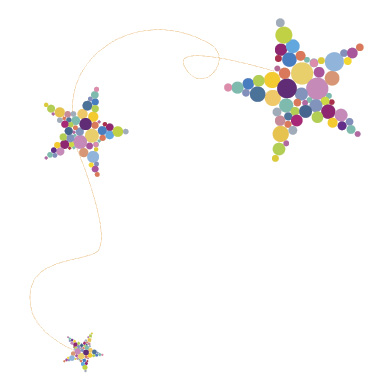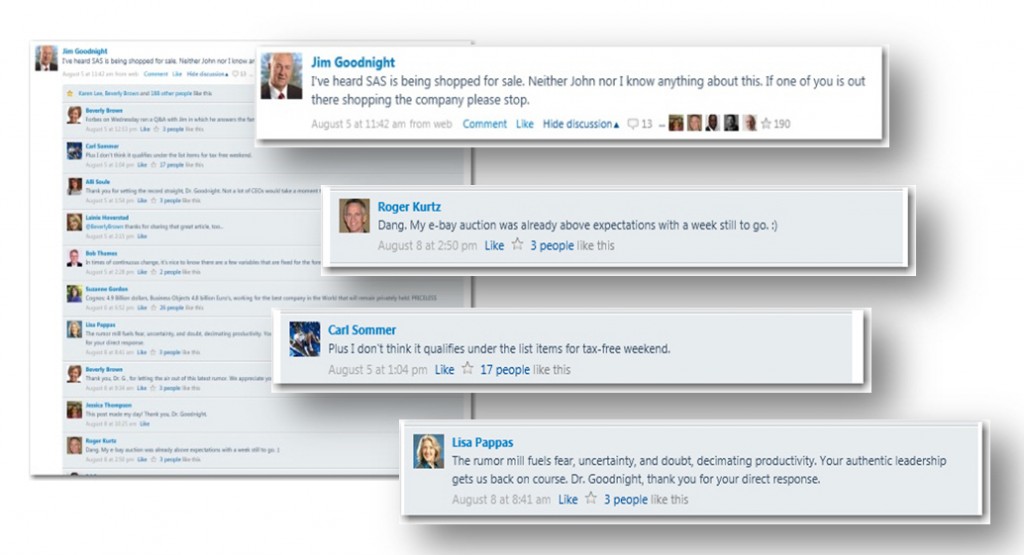 Do you ever feel like you can’t talk to the executives or have a voice that matters in your workplace? Have you ever wondered why changes in communication can’t take place within your work space? Like you can’t share your knowledge with others because you simply don’t know them, how to contact them or even what they do for the company?
Do you ever feel like you can’t talk to the executives or have a voice that matters in your workplace? Have you ever wondered why changes in communication can’t take place within your work space? Like you can’t share your knowledge with others because you simply don’t know them, how to contact them or even what they do for the company?
All of these challenges boil down to one thing: Trust. Most companies don’t realize that. Fortunately, SAS does. And trust goes a long way in establishing a great workplace.
For the past 28 years at SAS, I have seen communication tactics and strategies transform within our company. The days of posting newsletters on bulletin boards, or distributing handwritten meeting notes a week later have given way to the days of communicating to thousands of people electronically through social media in seconds. Yes, that’s a lot of change; but, it’s change that makes a difference in how employees can work, feel trusted and be proud of their company.
Perhaps the secret is that the key to building trust starts at the top of our company, with our CEO, Jim Goodnight.
Back in the days…
We were not afraid of posting on a SAS bulletin board an internal newsletter that could be quickly copied and duplicated for unwanted eyes. We weren’t leery of printing a quarterly internal magazine on company updates (including revenue and sales figures) that could have easily been shared with anyone outside of these walls. We have never been hesitant to communicate sensitive information to employees. With today’s technology, employees will find a way to communicate regardless; so, we have to embrace new communication vehicles and technology and empower our employees to use it in the most productive manner possible.
Giving employees the freedom to communicate, and trusting them with sensitive company information makes them feel valued. Regardless of the medium, we’ve never been afraid to communicate to our employees. Our leader has always trusted that employees would know how to handle the information they received. Company information like revenue and future plans have never been withheld because he trusts that we respect the information. As a result, employees feel like they are a part of the process – this is our company, our family. It’s our job to protect our family.
The Hub
In 2010, internal communication took a giant leap at SAS with the launch of "the Hub.” It operates much like Facebook, but has our own corporate touches to it. It’s social, it’s mobile and it’s building trust to the highest index we have attained in years. Our employee trust index is 98 percent, as rated by the Great Place to Work institute (where we have ranked as a Best Company to Work For every year since the list began in 1997).
When I noticed that many employees (myself included) were having conversations about internal SAS happenings with colleagues via Facebook and LinkedIn, I realized there wasn’t a need for learning about social media. Rather, there was a need for a space where employees could communicate internally, just as they do with friends externally. It was time to bring the conversations about work INSIDE the firewall where we could keep our conversations private within our organization.
So, that is exactly what we did. Internal Communications provided SAS’ 13,000 + employees with a platform to which they can relate. It was a vehicle they trusted while feeling trusted themselves. In turn, employees have created more than 1,000 public and private groups on The Hub, such as: Photography, Adoption, Technology Practice, High Performance Computing and Mobile Computing.
If your employees are using a tool outside the doors of the company, give them a tool similar inside and you will see progress go viral just as we have inside the doors at SAS. While we have more than 9,700 global employees opted in on the Hub and communicating with each other around the world, we are also enticed with nearly 900 internal bloggers, plus micro blogging channels, wikis, , employee polls and story-telling, and open comments on all internal announcements and news stories. Now that is a true sign of trust.
Executive support
Not only do the employees hop on the Hub to provide information, share knowledge and get answers to questions, but so does our CEO and his executive leadership team. There’s not a better way to let employees know that a tool can be trusted than to have their CEO posting to the same social media platform and interacting with employees!
For example, when our CEO heard of an untrue rumor circulating about SAS being SOLD, he took to the Hub to address the issue with employees in the most honest (and even humorous) way he could. Employees were obviously appreciative and comments began pouring in to his post on the Hub.

Real-time efficiency
Like Facebook, we have seen the Hub being used daily for open conversation, town hall meetings and webcasts – allowing for live comments and questions as the meetings take place. Additionally, it’s used for large sales meetings using the private group feature to capture questions, comments, best practices and new goals and strategies discussed.
Unlike many companies today, where the top managers and executive leaders are locked behind closed doors, cutting costs while holding everybody's fate in their hands, SAS executives open their doors to everyone so they can know what's happening and go right to work with a high level of trust and focus on increasing the company’s revenue.
Global collaboration
In the past, a question may have taken days to get answered through email or even discussed amongst those employees you talk to on a daily basis. With the Hub, that same question can be answered in minutes from an employee across the world or in a different time zone that you may have never met before.
In 2012, a clear example of this took place on the Hub when a post to our Technology Practice Group came in from Australia with a question about our BI Technology. The question was posted at 2:52pm and the first response was at 2:55pm from an employee in United States. The second response came in at 2:57pm from Europe. Within 24 hours a total of 6 responses provided knowledge and expertise from 7 departments and 4 countries .
Trust
Are you leaning solely on the brainpower of your top leadership? Or, are you leveraging all of your employee assets?
Empower your employees to have these conversations in a comfortable, interactive place. Without them, you can do nothing. They help you accomplish your goals; now help them accomplish theirs by trusting their voices and give them a place to share it.
Becoming a best place to work requires trust, genuine trust from the top down. Knowing you have the support of your CEO to have transparency at all levels will build trust in a new way that your company has never seen before.
If you don’t believe me, just ask a SAS employee. They’ll tell you how trust, transparency and communication gives them – and their customers – the Power to Know TM how to make a difference in all aspects of their personal and professional lives.

2 Comments
I'm privileged to work for SAS, and this year's ranking is well deserved. You are so right that executive trust of employee ideas (such as the Hub) that make SAS a great place to work, or ideas that make our products better for our customers, are key reasons we consistently rank so highly! (I think the only downside is that we have too many good ideas surfacing and we can't act on them all.) Thanks for your contributions to this great workplace.
All the best communication tools and programs can't replace a foundational level of trust, which boils down to believing the best about the people you work with each day and knowing their conversations with one another will ultimately be constructive and real. Trust in the workplace may not be a common or even a natural thing, but SAS works hard to make sure it's the basis for the way we work. Great insights, Karen.